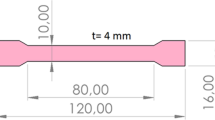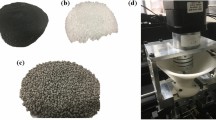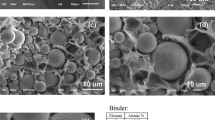Abstract
This study uses a composite material with copper powder added in Polylactide (PLA) to manufacture the metallic parts by 3D printing. The content of composite filament is with 90% copper and 10% PLA in terms of mass percentage. In practices, the printed parts are first printed using a 3D printer and then they are sintered in a high-temperature furnace to remove the PLA and strengthen their mechanical and thermal properties of the printed part. In this study, the sintering process is divided into two processes: (1) the heating process in which printed part is heated such that the PLA in the printed part is decomposed and then combusted away, and (2) the sintering process in which the contacting particles are bonded to form a solid object. A 3D numerical simulation has been performed to study the heat transfer characteristics of the system during heating process. In this study, a completion fraction is defined to indicate the local completion level between the thermal decomposition and the combustion reactions of the PLA in the printed parts.











Similar content being viewed by others
Abbreviations
- \(T_{{\text{d}}}\) :
-
Thermal decomposition temperature
- \(T_{{\text{i}}}\) :
-
Ignition temperature
- \(T_{{\text{f}}}\) :
-
Local temperature in the filament domain
- \(T_{0}\) :
-
Initial temperature
- \(T_{{\text{H}}}\) :
-
Final temperature
- \(T_{{\text{A}}}\) :
-
Absolute temperature
- \(T\) :
-
Temperature field
- \(C\) :
-
Heat capacity
- \(k\) :
-
Thermal conductivity
- \({\mathbf{q}}\) :
-
Heat flux by convection
- \({\mathbf{u}}\) :
-
Velocity vector
- \(\rho\) :
-
Density
- α :
-
Thermal diffusivity
- g:
-
Graphite powder
- c:
-
Copper filament
- 1:
-
The state of raw copper powder/PLA filament
- 2:
-
The state of the sintered parts
References
Gebhardt A (2011) Understanding additive manufacturing. Carl Hanser Verlag, Berlin (ISBN: 978-3-446-42552-1)
The Virtual Foundry homepage: https://www.thevirtualfoundry.com/ (still available on July 2021)
Laureto J, Tomasi J, King JA, Pearce JM (2017) Thermal properties of 3-D printed polylactic acid-metal composites. Progress Addit Manuf 2:57–71
Ebrahimi ND, Ju YS (2018) Thermal conductivity of sintered copper samples prepared using 3D printing-compatible polymer composite filaments. Addit Manuf 24:4 (Int. J. Heat Mass Trans. 60 May 2013)
Ayeni OI (2018) Sintering and characterization of 3D printing bronze filament. Master Thesis, Department of Mechanical Engineering, Perdue University, Indianapolis, Indiana, December 2018
Zhang Y-J (2021) Fabrication of metallic parts by 3D printing using metallic powder-polylactide composite filament. Mater Thesis, Department of Aeronautics and Astronautics, National Cheng Kung University, January 2021
Ikada Y, Tsuji H (2000) Biodegradable polyesters for medical and ecological applications. Macromol Rapid Commun 21:117–132
Wang G, Li A-M, Li J-F (2009) “基於 TG/FT-IR, Py-GC/MS 的聚乳酸塑料熱降解研究,”高校化學工程學報, 23: 957–961. (Chinese article)
Butt J, Bhaskar R (2020) Investigating the effects of annealing on the mechanical properties of FFF-printed thermoplastics. J Manuf Mater Process 4(2):38
Hwang S, Reyes EI, Moon KS, Rumpf RC, Kim NS (2014) Thermo-mechanical characterization of metal/polymer composite filaments and printing parameter study for fused deposition modeling in the 3D printing process. Miner Metals Mater Soc 44(3):771–777
Kear G, Barker BD, Walsh FC (2004) Electrochemical corrosion of unalloyed copper in chloride media-a critical review. Corros Sci 46:109–135
ASTM Standard E8/E8M-09, Standard Test Method for Tension Testing of Metallic Materials, ASTM.
http://www2.ucdsb.on.ca/tiss/stretton/database/Specific_Heat_Capacity_Table.html (still available on October 2020).
Pietrak K, Wisniewski TS (2015) A review of models for effective thermal conductivity of composite materials. J Power Technol 95(1):14–24
Properties and characteristics of graphite for the semiconductor industry. Technical report, Entegris, Inc., May 2013
Vachon RI, Prakouras AG, Crane R, Khader MS (1973) Thermal conductivity of heterogeneous mixtures and lunar soils. Technical report, NASA (No. NAS8–26579), Oct. 1973
Acknowledgements
Financial support from Ministry of Science and Technology, Taiwan, under Grant MOST 109-2622-E-006-011-CC2, is highly appreciated.
Author information
Authors and Affiliations
Corresponding author
Additional information
Publisher’s Note
Springer Nature remains neutral with regard to jurisdictional claims in published maps and institutional affiliations.
Rights and permissions
About this article
Cite this article
Cheng, CH., Loh, CC. & Zhang, YJ. Simulation of metallic parts by 3D printing using metallic powder–polylactide composite filament. Prog Addit Manuf 7, 495–508 (2022). https://doi.org/10.1007/s40964-022-00287-6
Received:
Accepted:
Published:
Issue Date:
DOI: https://doi.org/10.1007/s40964-022-00287-6




